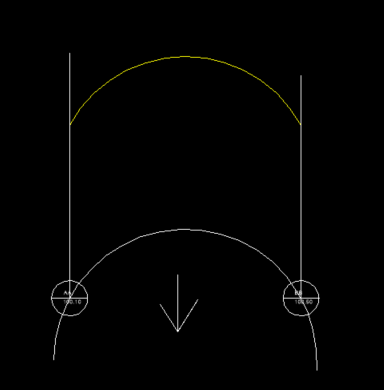Leaderboard
Popular Content
Showing content with the highest reputation on 05/24/2024 in all areas
-
I added some comments below to show what it does differently. Mostly its just a loop instead of the same code 6 times. The Dynamic block functions are not for changing attributes but the different custom properties a dynamic block can have. For changing attributes you can look at the other link CyberAngel provided on the other post. But since you are trying to fill in a dynamic block that looks just like a mleader, why not just use an actual mleader like this: (defun c:testKRIS ( / *error* dch dcl des mv d1 d2 d3 d4 d5 d6) (defun *error* ( msg ) (if (and (= 'int (type dch)) (< 0 dch)) (unload_dialog dch) ) (if (= 'file (type des)) (close des) ) (if (and (= 'str (type dcl)) (findfile dcl)) (vl-file-delete dcl) ) (if (and msg (not (wcmatch (strcase msg t) "*break,*cancel*,*exit*"))) (princ (strcat "\nError: " msg)) ) (princ) ) (cond ( (not (setq dcl (vl-filename-mktemp nil nil ".dcl") des (open dcl "w") ) ) (princ "\nUnable to open DCL for writing.") ) ( (progn (foreach str '( "ed : edit_box" "{" " alignment = left;" " width = 20;" " edit_width = 10;" " fixed_width = true;" "}" "" "test : dialog" "{" " spacer;" " key = \"dcl\";" " : ed" " {" " key = \"mv\";" " label = \"MV:\";" " }" " :boxed_column { " " label = \"Diepte vd buizen\";" " :row {" " : ed" " {" " key = \"d1\";" " label = \"A:\";" " }" " : ed" " {" " key = \"d4\";" " label = \"X:\";" " }}" " :row {" " : ed" " {" " key = \"d2\";" " label = \"B:\";" " }" " : ed" " {" " key = \"d5\";" " label = \"Y:\";" " }}" " :row {" " : ed" " {" " key = \"d3\";" " label = \"C:\";" " }" " : ed" " {" " key = \"d6\";" " label = \"Z:\";" " }}" " }" " : boxed_row" " { " " label = \"BOK berekeningen\";" " :column {" " : ed { key = \"res\"; label = \"BOK:\"; is_enabled = false; }" " : ed { key = \"res2\"; label = \"BOK2:\"; is_enabled = false; }" " : ed { key = \"res3\"; label = \"BOK3:\"; is_enabled = false; }" " }" " :column{" " : ed { key = \"res4\"; label = \"BOK4:\"; is_enabled = false; }" " : ed { key = \"res5\"; label = \"BOK5:\"; is_enabled = false; }" " : ed { key = \"res6\"; label = \"BOK6:\"; is_enabled = false; }" " }" " }" " : button" " {" " key = \"cal\";" " label = \"Calculate\";" " }" " spacer;" " ok_only;" "}" ) (write-line str des) ) (setq des (close des) dch (load_dialog dcl) ) (<= dch 0) ) (princ "\nUnable to load DCL file.") ) ( (not (new_dialog "test" dch)) (princ "\nUnable to display 'test' dialog.") ) ( t (set_tile "dcl" "Calculate Area") (action_tile "mv" "(setq mv $value)") (action_tile "d1" "(setq d1 $value)") (action_tile "d2" "(setq d2 $value)") (action_tile "d3" "(setq d3 $value)") (action_tile "d4" "(setq d4 $value)") (action_tile "d5" "(setq d5 $value)") (action_tile "d6" "(setq d6 $value)") (action_tile "cal" (vl-prin1-to-string '( (lambda ( / m) (foreach box '("res" "res2" "res3" "res4" "res5" "res6") (set_tile box "") ) (if (and mv (setq m (distof mv))) (progn (setq lijst_results (cons ; Add item to start of a list (strcat "MV: " mv "\\P") ; Add MV to the list before saving to lijst_results (mapcar ; Loop function (lambda) over 3 lists '(lambda (box naam var / a v) ; Function (if (and ; Checks from your code var (setq a (distof var)) (setq v (rtos (- m a) 2 2)) ; Save string in a variable since its used twice ) (progn (set_tile box v) (strcat naam ": " v "\\P") ; return to list including enter ) (progn "" ) ) ) (list "res" "res2" "res3" "res4" "res5" "res6") ; List 1 called Box (list "A" "B" "C" "X" "Y" "Z") ; List 2 called Naam (list d1 d2 d3 d4 d5 d6) ; List 3 called Var ) ) ) ) (alert "Vul maaiveld waarden in.") ) ) ) ) ) (start_dialog) (if lijst_results (command "_mleader" "\\" ; Pause for input startpoint "\\" ; Pause for position of text (apply 'strcat lijst_results) ; Fill in info ) ) ) ) (*error* nil) (princ) )1 point
-
Because you want a yellow pline section working with curves in a pline it is difficult, a quick workaround is copy the pline say to right 200 then adjust the 2 points chosen points X+200, trim the pline both ends, change its layer so becomes yellow, move it back -200, all done. Removes all the headaches of trimming and remaking plines. No Code at this stage just a suggestion. Image shows idea.1 point
-
If your paying for the dwg file then insist that you get what you want, not what they want to give you. If not get another contractor. We supplied a CIV3D file and surface 3dfaces if they were using non CIV3D.1 point
-
1 point
-
Try this modification of your code - minimally tested, but I am exploiting using inters and polar to work with linear, rotated, or aligned dimensions at any angle. Doesn't do anything on any other type of dimension. (defun C:D2 (/ cmd osm olderr ss PT index DS N13 N14) (setq cmd (getvar "CMDECHO") osm (getvar "OSMODE") olderr *error* *error* myerror ) (princ "Please select dimension object!") (setq ss (ssget '((0 . "DIMENSION")))) (setq PT (getpoint "\nPoint to trim or extend:") PT (trans PT 1 0) ) (command "UCS" "_W") (repeat (setq index (sslength ss)) (setq DS (entget (ssname ss (setq index (1- index)))) dtyp (cdr (assoc 70 ds)) ) (cond ((member dtyp (list 32 160))(setq ang (cdr (assoc 50 ds)))) ((member dtyp (list 33 161))(setq ang (angle (cdr (assoc 13 ds)) (cdr (assoc 14 ds))))) ) (if ang (progn (setq n13 (inters (cdr (assoc 13 ds)) (polar (cdr (assoc 13 ds)) (+ ang (/ pi 2)) 1) pt (polar pt ang 1) nil ) ds (subst (cons 13 n13) (assoc 13 ds) ds) n14 (inters (cdr (assoc 14 ds)) (polar (cdr (assoc 14 ds)) (+ ang (/ pi 2)) 1) pt (polar pt ang 1) nil ) ds (subst (cons 14 n14) (assoc 14 ds) ds) ) (entmod ds) ) ) ) (command "UCS" "_P") (setvar "CMDECHO" cmd) (setvar "OSMODE" osm) (setq *error* olderr) (princ) )1 point


